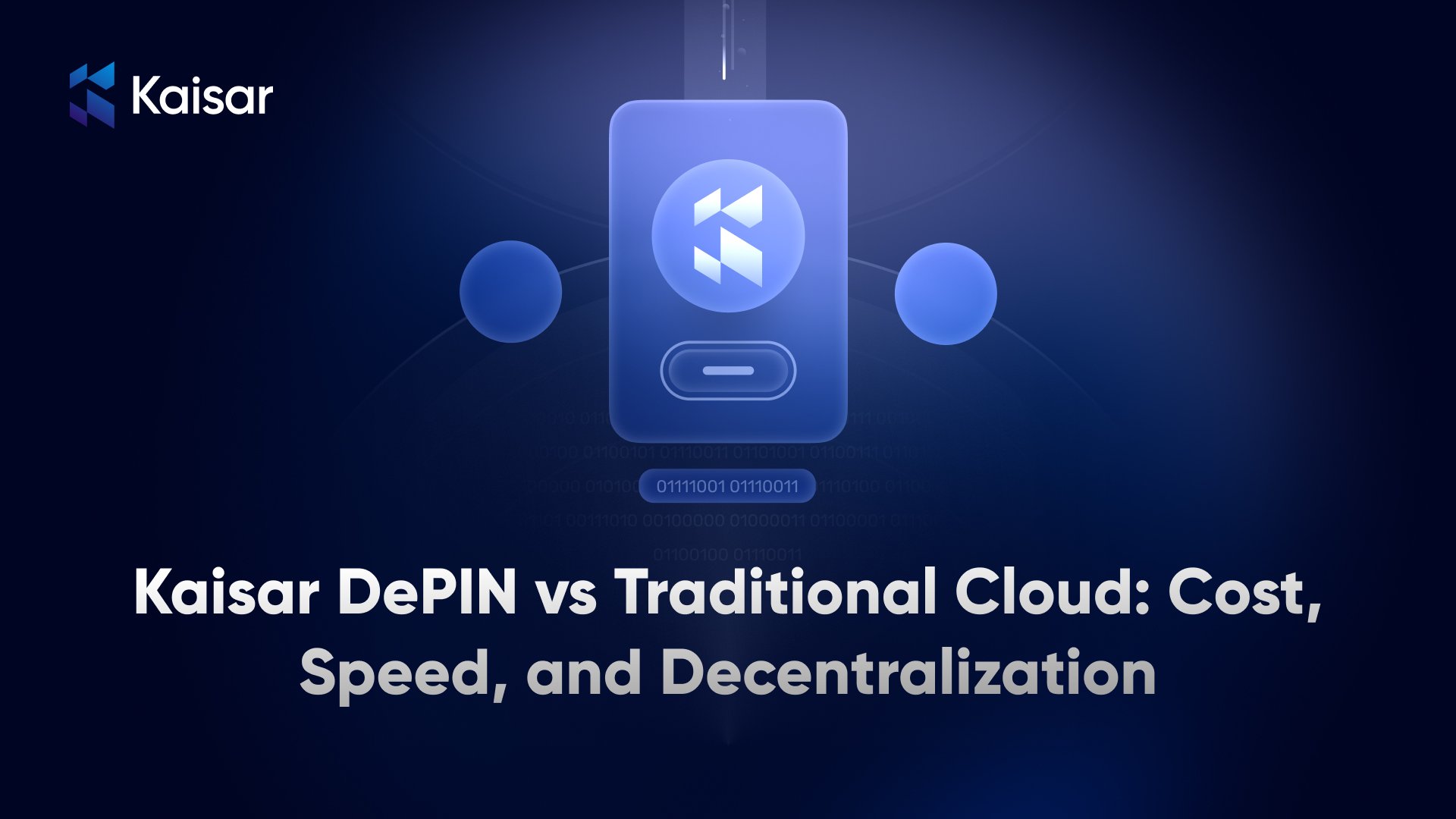In the fast-moving world of cloud computing, Decentralized Physical Infrastructure Networks (DePIN) has emerged as a competition to traditional cloud providers like AWS, Microsoft Azure and Google Cloud.
Leveraging DePIN, many offerings such as Kaisar Network aims to decentralize infrastructure, giving contributors power and purpose to democratize computing resources.
This article will compare Kaisar DePIN against traditional cloud infrastructure in cost, speed, and decentralization. Each aspect reveals its own distinct drawbacks and features that developers and users must consider when selecting a cloud service for their applications.
Kaisar DePIN
Kaisar is a decentralized cloud network which mobilize idle computing resources from contributors (or “node operators”) who are compensated with tokens or direct payments. Instead of consolidating its workloads to massive centralized data centers, Kaisar’s workload is distributed to a globally decentralized infrastructure.
Kaisar’s model aligns with Web3 principles of: permissionless access, token incentives, community governance, and open-source transparency.
Kaisar vs Traditional Cloud
Cost
Traditional providers operate on a pay-as-you-go model, or via a subscription, and have their own flexibility and scalability for compute workloads.
But traditional clouds become expensive due to over-provisioning of resources, ingress/egress fees (transferring data), licensing costs (e.g., machine learning services, databases),and vendor lock-in which makes it hard to switch between clouds with costs.
On the other side Kaisar DePIN uses a provider-driven pricing model, where compute providers complete jobs with their given resources and price. With peer-to-peer cloud infrastructure.Kaisar, compared to traditional cloud infrastructure, can offer lower baseline pricing, especially in less utilized areas.
Pricing is mostly transparent, and there are no hidden fees, Kaisar markets itself as a more cost-effective model where cloud jobs (computing) can share resources.
Speed and performance
Traditional cloud providers have high-speed data centers with state-of-the-art networking. One of the things they do is operate with regional zones (like AWS US-East-1) which help optimize latency.
Where traditional cloud infrastructure offers vendors and service level agreements which help but they also have systemic constraints with global coverage and do not execute well in developing countries where infrastructure fails to invest in a localized zones.
This is where Kaisar DePIN has an advantage it operates as a decentralized mesh network of contributors that enables performance that is variable depending on the node. The network coverage is also global even where main providers do not operate.
Overall traditional cloud providers are still ahead for latency-based workloads but Kaisar is a better fit for non-real-time workloads (e.g., distributed training, GPU render farms, file storage).
Decentralization: Control and Censorship
Despite the reliability and scale, traditional cloud providers are essentially centralized and censorable as they are under government oversight and geopolitical threats.
Creating single points of failure situations which usually traditional cloud providers does may impact hundreds of instances running if the vendor decides to act out of violations in terms-of-service or through legal actions.
Therefore, the traditional cloud architecture does not provide reliable forms of resilience where autonomy, privacy, and censorship-resistance are the focus.
Kaisar DePIN on the other hand implements blockchain principles, which guarantees anyone with hardware can contribute and no central organization can take away anyone’s access
All upgrades and cost metrics are decided by the community through token/DAO voting and users can have choice over what jurisdiction is chosen for the nodes and therefore influences regulations.
Comparison Table
| Kaisar DePIN | Traditional Cloud Providers (AWS, Azure, Google Cloud) |
| Lower, transparent pricing; peer-to-peer; no hidden fees | Pay-as-you-go/subscription; expensive due to overprovisioning, egress, licensing |
| Provider-driven (market- based) | Vendor-driven (fixed rates, often opaque) |
| Variable; depends on node; best for non-real- time workloads | High-performance; optimized latency via regional zones |
| Distributed globally, including underserved regions | Strong in developed countries; limited in developing areas |
| Fully decentralized; governed by DAO and blockchain principles | Centralized; controlled by corporations, subject to TOS and regulatory control |
| High; open participation; no single authority | Low; vulnerable to takedowns, central control, and regulation |
Conclusion
The idea that Kaisar DePIN and traditional cloud providers are competing for is far more subjective than what we are imagining in the article. If an organization value predictable performance, customer support, and integrations offered by the cloud provider, then traditional cloud providers can’t be matched by Kaisar Network in current lifecycle. If an organization value cost efficient, censorship-resistance, and global reach with no gatekeepers, then they should start integrating Kaisar DePIN into their infrastructure plans.
As of today hybrids are the best path forward by taking a lifecycle approach that uses Kaisar for a back-end computation activities while still using the traditional cloud providers for front-end or low-latency API.
As the decentralized cloud moves into maturity, through the Kaisar ecosystem, it could help form the paradigms of computing, transforming data centers into open, community- involved infrastructures to make it accessible for collaborators to engage and build value.
Join Kaisar Network
Ready to scale your projects with affordable GPU resources? Join Kaisar Network today and harness the power of DePIN. Visit kaisar.io to get started!

